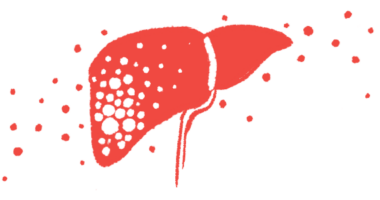CF-related Liver Disease Raises Risk of Death in Some Pediatric Patients

The frequency of cystic fibrosis-associated liver disease (CFLD) has increased in the past two decades and is linked to several simultaneous health complications, a U.S. study shows.
CFLD was also found to be independently associated with a higher risk of mortality and increased healthcare resource use in children hospitalized due to cystic fibrosis (CF).
These findings highlight the importance of diagnosing CFLD early on to monitor and manage its associated complications, with the aim to potentially prevent mortality in children with CF, the researchers noted.
The study, “Cystic Fibrosis-Related Liver Disease is an Independent Risk Factor For Mortality And Increased Health Care Resource Utilization In Hospitalized Pediatric Patients With Cystic Fibrosis,” was published in the journal Pediatric Pulmonology.
With the increasing lifespan of people with CF due to improved therapies, nonlung complications have emerged as significant contributing factors to the disease’s burden, with CFLD being the third leading cause of death in these patients.
While the mechanisms by which CF leads to liver disease are largely unclear, a previous study in mouse models suggested that a missing or defective CFTR protein — the underlying cause of CF — may indirectly promote liver inflammation and scarring.
Liver abnormalities in CF patients typically emerge during early childhood, and “almost 75% of the CF patients requiring liver transplantation are children, further highlighting the importance of early recognition of CFLD and evaluating its impact in the management of CF patients,” the researchers wrote.
Previous studies in children have showed that CFLD is associated with “increased mortality, adverse hospital outcomes, and severe disease,” but little is known, at a population level, about “the impact of CFLD on the hospital outcome of pediatric patients,” the researchers added.
To address this, a team of scientists in the U.S. analyzed data from the National Inpatient Sample (NIS) and Kids’ Inpatient Database (KID) between 2003 and 2016 to assess potential links between CFLD and mortality and hospital outcomes.
These are the U.S.’s largest publicly available, all-payer inpatient care databases for all patients (NIS) and for those under the age of 21 (KID), covering more than 97% of the population. NIS releases data every year, while KID data is released every three years since 1997, with an absence in 2015 due to health code transitions.
The researchers analyzed data from all hospitalized CF patients up to 20 years of age in the KID database in 2003, 2006, 2009, 2012, and 2016, and in the NIS database in 2004–05, 2007–08, 2010–11, and 2013–15.
Demographic information, simultaneous health conditions, in-hospital mortality, length of stay, and hospital charges were compared between patients with and without CFLD.
Health codes for liver fibrosis, cirrhosis (late and severe stage of liver scarring), chronic liver disease, portal hypertension, enlarged liver and spleen, overly active spleen, and liver transplant status were considered as proxies for a CFLD diagnosis. Portal hypertension refers to elevated blood pressure in the vein leading to the liver.
A total of 94,374 CF-related hospitalizations were included in the analysis, and CFLD was present in 5.8% of these hospitalizations. Notably, CFLD frequency in CF-related hospitalizations significantly increased over time — with the lowest value in 2003 (3.1%) and the highest in 2014 (7.3%) — and with age, with a peak rate of 8.2% at age 19.
Hospitalized CF patients with liver disease were significantly older (mean 14.3 vs. 12.5 years) and more likely to be boys (52.2% vs. 44.4%) and Caucasian (70.9% vs 67.7%) relative to those without liver disease.
Also, most simultaneous health conditions or complications were significantly more common in hospitalizations with CFLD.
These included lung failure (6.1% vs. 4.5%), intubation and mechanical ventilation (4.4% vs. 2.4%), diabetes (14.3% vs. 8.2%), anemia (9.4% vs. 3.8%), malnutrition (16.4% vs. 12.9%), and need for parenteral nutrition (3.7% vs. 1.7%), among others. Parenteral nutrition is that given directly into the bloodstream.
Compared with CF-related hospitalizations without CFLD, those with liver disease had a significantly higher in-hospital mortality rate (1.2% vs. 0.4%), lasted significantly longer (median 10 vs. nine days), and cost significantly more (median $52.871 vs. $42.752).
When adjusted for potential influencing factors, data also showed that CFLD was independently and significantly associated with a 2.1 times increased risk of inpatient mortality, with 1.1 additional days of hospital stay, and with $14,852 additional hospitalization charges.
These findings highlight that CFLD frequency has increased in hospitalized CF patients “over the last 2 decades and is associated with multiple comorbidities which are likely related to the increased life expectancy of CF patients,” the team wrote.
Also, CF-related liver disease “is associated with multiple comorbidities and is independently associated with increased risk of mortality and increased health care resource utilization in pediatric CF-related hospitalizations,” they researchers wrote.
As such, “recognizing CFLD earlier may help clinicians to manage complications of CFLD such as malnutrition … more aggressively and also may plan for timely interventions such as liver transplant,” they added.
Among the study’s limitations, the team noted that “each record represents a hospitalization encounter and not individual patients,” which “may falsely overestimate or underestimate the prevalence and mortality rates.”
Future studies, following children with CF over time, are needed to help better understand CFLD’s underlying mechanisms and natural course, as well as its impact on hospital outcomes.








